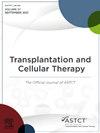Jak Inhibitor Itacitinib with Ptcy and Tacrolimus to Prevent Gvhd in a Myeloablative Fractionated Busulfan Regimen: A Phase 2 Trial
IF 3.6
3区 医学
Q2 HEMATOLOGY
引用次数: 0
Abstract
Background
Fractionating busulfan and giving it over a longer period, along with post-transplant cyclophosphamide (PTCy) graft versus host disease (GVHD) prophylaxis, reduces toxicity and allows for the safe administration of a myeloablative regimen in older patients. Based on the activity of ruxolitinib, a Jak inhibitor, in treating GVHD, we reasoned that a Jak inhibitor may prevent GVHD. We replaced MMF with the JAK1 inhibitor itacitinib, hypothesizing that it will further reduce GVHD and improve outcomes of this novel fractionated busulfan regimen. We tested this in an investigator-initiated phase 2 study.
Patients and Methods
Patients with hematologic malignancies were eligible for this study if they were 18-70 years old and had adequate organ function. Donor was a matched or haploidentical related donor or 7/8 or 8/8 unrelated donor. Busulfan was given as follows, with a total course AUC target of 16,000 ± 12%: days -20, -13, and -6 through -3. Busulfan on days -20 and -13 was dosed 100 mg/m2, with pharmacokinetics performed on day -20 to further guide dosing and repeated on day -6. Thiotepa 5 mg/kg was given on day -7 and fludarabine 30 mg/m2 on days -6 to -3. GVHD prophylaxis was PTCy 50 mg/kg on days +3 and +4 and tacrolimus starting on day +5. Itacitinib 200 mg daily was given from day +5 to +50 and 100 mg from days 51-60 (ClinicalTrials.gov: NCT04127721).
Results
31 patients with a median age of 62 (25-69) years were enrolled: 10 (32%) patients had AML, 10 (32%) myelofibrosis, 6 (19%) MDS, 1 each CLL, lymphoma, CML, myeloma, and ALL. Donor was a matched sibling in 7 (23%), matched unrelated in 17 (55%), mismatched unrelated in 2 (5%) and haploidentical in 5 (16%). Comorbidity score was ≥3 in 42%. Peripheral blood was the graft source in 28 (90%).
At day 100, cumulative incidence (CI) of grade 2-4 acute GVHD was 26% (10-42%), which occurred in 8 patients; 5 of which occurred after itacitinib was tapered on day 50. The CI of grade 3-4 GVHD was 6.5% (0-15%). Moderate to severe chronic GVHD was seen in 4.5% (0-13%). There were no GVHD related deaths. Seven patients died: 2 due to cardiac failure and 1 each due to bacterial infection, COVID infection, sinusoidal obstruction syndrome, graft failure and relapsed disease. Twenty-four patients are alive and disease free. With a median follow up of 18 months, 1-year overall survival, progression-free survival, GVHD-free relapse free survival, non-relapse mortality, and relapse rate are 81%, 81%, 70%, 16%, and 3.2% respectively.
Median time to neutrophil engraftment was 16.5 (13-29) days and platelet engraftment was 29 (13-240) days. At day 30, T cell chimerism was 100% (61-100) donor and myeloid chimerism was 100% (100-100) donor. Common (>10%) grade 3-5 toxicities were bacterial infection in 39% and febrile neutropenia in 54% of patients.
Conclusion
These encouraging results warrant further studies to evaluate the role of JAK inhibitors to prevent GVHD, replacing MMF.
求助全文
约1分钟内获得全文
求助全文
来源期刊

Transplantation and Cellular Therapy
Medicine-Hematology
CiteScore
7.00
自引率
15.60%
发文量
1061
审稿时长
51 days
 求助内容:
求助内容: 应助结果提醒方式:
应助结果提醒方式:


